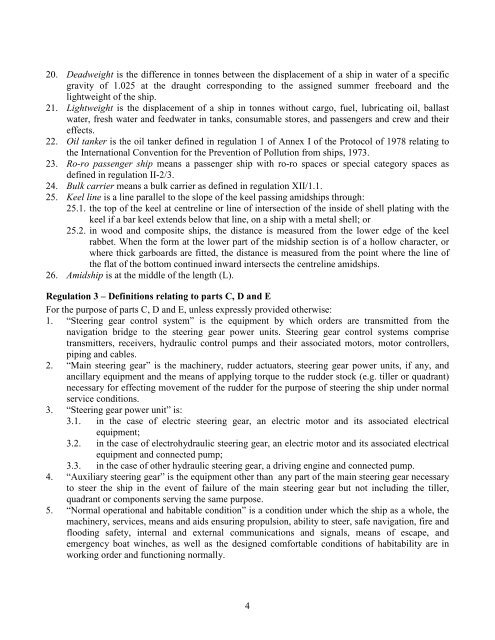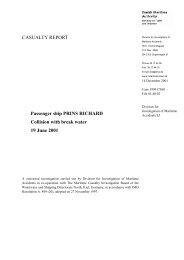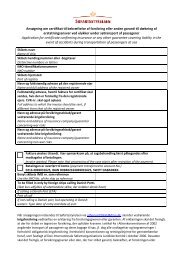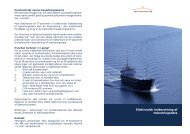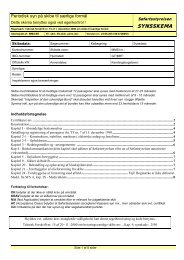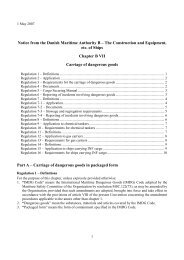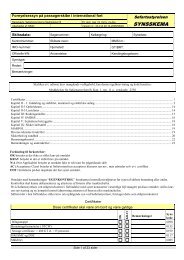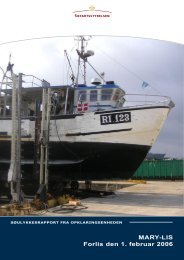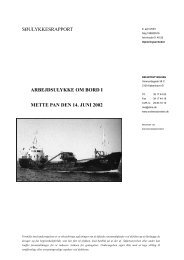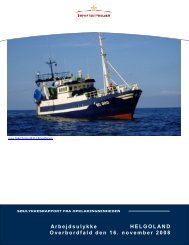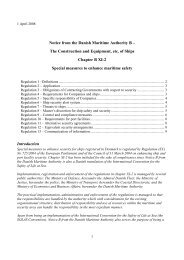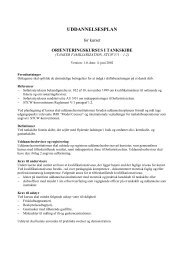Notice from the Danish Maritime Authority B
Notice from the Danish Maritime Authority B
Notice from the Danish Maritime Authority B
You also want an ePaper? Increase the reach of your titles
YUMPU automatically turns print PDFs into web optimized ePapers that Google loves.
20. Deadweight is <strong>the</strong> difference in tonnes between <strong>the</strong> displacement of a ship in water of a specific<br />
gravity of 1.025 at <strong>the</strong> draught corresponding to <strong>the</strong> assigned summer freeboard and <strong>the</strong><br />
lightweight of <strong>the</strong> ship.<br />
21. Lightweight is <strong>the</strong> displacement of a ship in tonnes without cargo, fuel, lubricating oil, ballast<br />
water, fresh water and feedwater in tanks, consumable stores, and passengers and crew and <strong>the</strong>ir<br />
effects.<br />
22. Oil tanker is <strong>the</strong> oil tanker defined in regulation 1 of Annex I of <strong>the</strong> Protocol of 1978 relating to<br />
<strong>the</strong> International Convention for <strong>the</strong> Prevention of Pollution <strong>from</strong> ships, 1973.<br />
23. Ro-ro passenger ship means a passenger ship with ro-ro spaces or special category spaces as<br />
defined in regulation II-2/3.<br />
24. Bulk carrier means a bulk carrier as defined in regulation XII/1.1.<br />
25. Keel line is a line parallel to <strong>the</strong> slope of <strong>the</strong> keel passing amidships through:<br />
25.1. <strong>the</strong> top of <strong>the</strong> keel at centreline or line of intersection of <strong>the</strong> inside of shell plating with <strong>the</strong><br />
keel if a bar keel extends below that line, on a ship with a metal shell; or<br />
25.2. in wood and composite ships, <strong>the</strong> distance is measured <strong>from</strong> <strong>the</strong> lower edge of <strong>the</strong> keel<br />
rabbet. When <strong>the</strong> form at <strong>the</strong> lower part of <strong>the</strong> midship section is of a hollow character, or<br />
where thick garboards are fitted, <strong>the</strong> distance is measured <strong>from</strong> <strong>the</strong> point where <strong>the</strong> line of<br />
<strong>the</strong> flat of <strong>the</strong> bottom continued inward intersects <strong>the</strong> centreline amidships.<br />
26. Amidship is at <strong>the</strong> middle of <strong>the</strong> length (L).<br />
Regulation 3 – Definitions relating to parts C, D and E<br />
For <strong>the</strong> purpose of parts C, D and E, unless expressly provided o<strong>the</strong>rwise:<br />
1. “Steering gear control system” is <strong>the</strong> equipment by which orders are transmitted <strong>from</strong> <strong>the</strong><br />
navigation bridge to <strong>the</strong> steering gear power units. Steering gear control systems comprise<br />
transmitters, receivers, hydraulic control pumps and <strong>the</strong>ir associated motors, motor controllers,<br />
piping and cables.<br />
2. “Main steering gear” is <strong>the</strong> machinery, rudder actuators, steering gear power units, if any, and<br />
ancillary equipment and <strong>the</strong> means of applying torque to <strong>the</strong> rudder stock (e.g. tiller or quadrant)<br />
necessary for effecting movement of <strong>the</strong> rudder for <strong>the</strong> purpose of steering <strong>the</strong> ship under normal<br />
service conditions.<br />
3. “Steering gear power unit” is:<br />
3.1. in <strong>the</strong> case of electric steering gear, an electric motor and its associated electrical<br />
equipment;<br />
3.2. in <strong>the</strong> case of electrohydraulic steering gear, an electric motor and its associated electrical<br />
equipment and connected pump;<br />
3.3. in <strong>the</strong> case of o<strong>the</strong>r hydraulic steering gear, a driving engine and connected pump.<br />
4. “Auxiliary steering gear” is <strong>the</strong> equipment o<strong>the</strong>r than any part of <strong>the</strong> main steering gear necessary<br />
to steer <strong>the</strong> ship in <strong>the</strong> event of failure of <strong>the</strong> main steering gear but not including <strong>the</strong> tiller,<br />
quadrant or components serving <strong>the</strong> same purpose.<br />
5. “Normal operational and habitable condition” is a condition under which <strong>the</strong> ship as a whole, <strong>the</strong><br />
machinery, services, means and aids ensuring propulsion, ability to steer, safe navigation, fire and<br />
flooding safety, internal and external communications and signals, means of escape, and<br />
emergency boat winches, as well as <strong>the</strong> designed comfortable conditions of habitability are in<br />
working order and functioning normally.<br />
4


